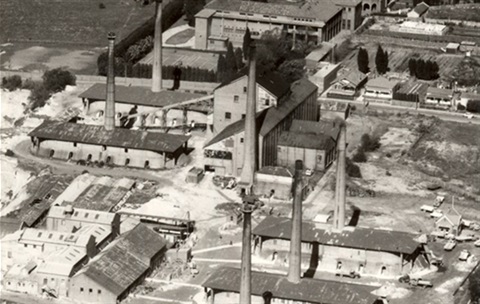Northcote Brickworks

The Northcote Brickworks had its origins in 1866 when publican John Roberts discovered quality clay soil at the rear of his hotel, the Carter’s Arms, in Separation Street Northcote. Once the quantity and quality of the clay deposits became known Roberts sold a large stretch of his property to Seymour and Charles Groom. The Groom brothers began raising funds to establish the Patent Brick Co. and work the site at a commercial level. Bricks began to leave the site in 1873 and using a single chimney stack was able to produce between one and two million bricks per annum.
In 1882 a group of Melbourne businessmen joined together to form the Northcote Brick Co. Ltd. They bought out the Patent Brick Company, gaining 8 acres in Separation Street including a 40 foot quarry. The next year the Northcote Brick Company floated 30,000 shares although George Plant and John Roberts were the only locals to invest in the venture. The same year the company invested in a Hoffman kiln. Developed in 1858, the Hoffman kiln used a circular arrangement of chambers to allow continuous firing, a process which allowed for a faster and more efficient production of bricks. A second and third kiln was added in 1886. The impact on production was dramatic and by 1889 the brickworks was producing 4 million bricks per month, a far cry from the million bricks per annum of the Patent Brick Co. Such was the success of the brickworks that a rival company, the New Northcote Brick Company opened in Dennis Street in the late 1880s. The two companies were to be rivals for many years.
In 1889 a serious strike between the carters and the brickworks caused some disruption to production but this was just a prelude to the disastrous effects of the depression which struck the following year. Brick prices tumbled and the brickworks stopped production for two months, only surviving by selling off their stockpile of unsold bricks.
The New Northcote Brickwork Company was able to keep going but at a greatly reduced pace. The closure and partial closure of the two brickworks had a serious flow on effect on all of Northcote. Not only did the two brickworks employ over 500 people but many local businesses depended upon the brickworks for trade. Northcote suffered. After two months the Northcote Brick Company resumed production although staffing levels remained greatly reduced and only two out of five kilns were in action. Output was down by 10.5 million bricks.
As the 1890s dragged on the brickworks closed on several occasions as the market ebbed and flowed. It was during this period that a brick cartel was formed with several leading brickworks and this helped stabilise and then push up brick prices. Despite this employment during this period continued to be well below the peak of 1889.
The outbreak of the First World War did not slow the growth of the company and in 1919 new steamworks were installed in the Northcote brickworks. By the 1920s the Northcote Brick Co. was enjoying record profits. However another depression was just around the corner.
The 1930 depression hit the brickworks hard. In 1924-5 669 homes were built in Northcote, the depression brought that down to a mere 12 in 1931. The brickworks closed down for extended periods. In 1936 the Northcote Brick Co. sold the undeveloped land immediately behind the Carter’s Arms Hotel to the Northcote Council. The Council planned to use the land to establish the Thomson Reserve (after longstanding Town Clerk, John Thomson). The park never really developed and sadly became a car park in the 1960s. In 1982 the site became part of the Northcote Central.
By the end of the 30s the Northcote Brick Co. had began to recover although staff levels hovered around the 100 mark. Business continued over the next twenty years, marked in 1962 by the merging of the Northcote Brick Co. and the New Northcote Brick Co.; thereby bringing to an end 60 years of rivalry. Subsequent mergers saw the company join with Nubrik and Clifton Bricks to form the Austral Brick Company.
By the 1970s suburbia had surrounded the brickworks and in 1977 it sold the quarry to the Northcote Council for use as a tip. The unquarried area to the west of the site remained in the companies hands and included the chimneys and the brickworks buildings. Two years later this area was levelled and the site sold to developers. In 1981 the Northcote Plaza was constructed on the site of the former kilns. The former quarry ceased operating as a tip in 1998 and in 2002 was opened as All Nations Park.
Lemon, Andrew (1983). The Northcote Side of the River. North Melbourne: Hargreen.